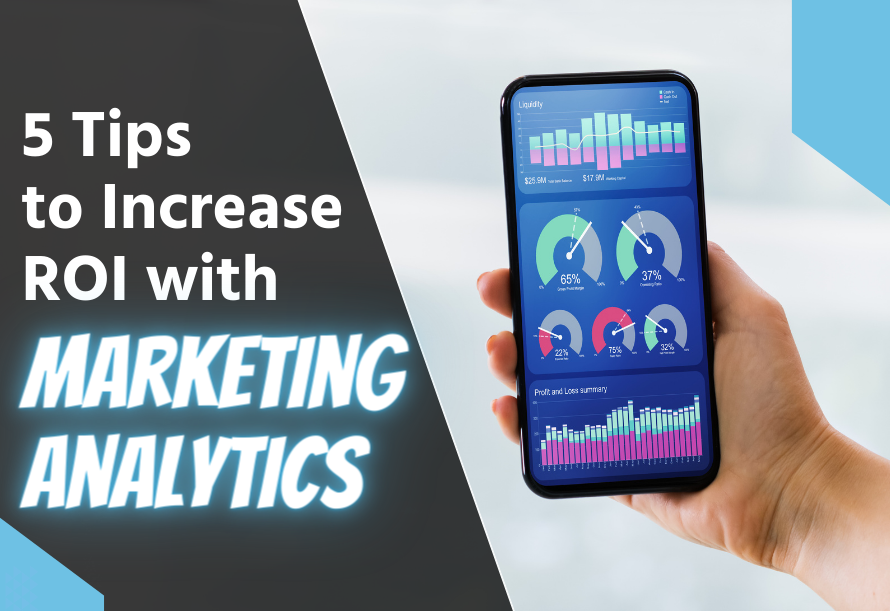5 Tips to Increase ROI with Marketing Analytics
Analytics are essential if you want to assess the success of your marketing initiatives and pinpoint areas that require improvement. Increasing ROI and knowing more about the performance of your initiatives require an understanding of how to read marketing data with the help of Marketing Analytics. Unfortunately, most businesses struggle to use data interpretation to increase sales.
Senior management could be perplexed and overwhelmed about how marketing statistics related to ROI, derived from unique visits to social media followers. Setting precise, short- and long-term goals is only the tip of the iceberg.
Marketing Analytics in a Nutshell
To assess the benefits and drawbacks of marketing activities, market analytics entails extensive data collection and analysis of numerous marketing methods. Of course, concentrating on KPIs (key performance indicators) and using them to decide which methods to keep employing and which to drop is how you optimize ROI. By integrating the most effective aspects of your methods, you may increase ROI by drawing conclusions from your data.
Establish a Marketing Objective
Creating a clear target and accompanying success criteria is the first step in boosting ROI with marketing analytics. What do you want your campaigns to achieve?
Make a preliminary outline to bring clarity to your plan. Analyze past data and identify any trends. After that, develop your outline into a thorough plan. Discover how to integrate analytics into your current procedures, such as sending marketing emails and introducing new items.
For instance, one campaign’s goal can be to boost conversions, while another’s goal would be to boost visitors to a certain landing page. The digital metrics you’ll use to gauge the effectiveness of your efforts in relation to your goals can then be chosen from there. To assess whether your marketing efforts are producing the expected outcomes, you would then use those measurements.
Don’t Use Vanity Metrics
If they increase, vanity metrics like Facebook friends and press release shares give us a positive feeling. However, they don’t aid in decision-making or have any connection to income. Your staff may be distracted from the corporate objective by these measures.
Instead, concentrate on ROI-related engagement indicators. You should also monitor data like revenue, customers, conversion rates, A/B tests, funnels, cohorts, and marketing campaigns.
Set ROI Goals
To plan and monitor progress, you must have a clearly stated objective. You won’t be able to monitor your campaigns to make sure they’re really worth the money if you don’t.
If you want to succeed in accomplishing your ROI targets, they too should be SMART. According to the acronym, SMART objectives are time-based, relevant (and practical), specified, measurable, achievable, and time-based. Marketers who define explicit objectives, such as ROI targets, have a roughly 376% higher chance of success than those who don’t. Make sure your ROI targets are attainable and well-defined before setting them.
Focus on launching a campaign objective before converging on ROI digital marketing. You should also focus on how to enhance ROI to prevent last-minute confusion. Think about complex elements including cost variables, market dynamics, and consumer demand. The ROI generated directly correlates with your marketing objectives. Concentrate on developing pre-planned techniques that provide outcomes in order to enhance ROI.
Carry Out Experiments Regularly
Conduct ongoing tests and stop putting things off if you want to have a profitable ROI. Utilize these professional, routine trials to accelerate your company’s growth and evaluate its performance. Compare the outcomes of the two action groups to ensure transparency and accessibility. Establishing a budget for your tests and choosing a focal area can help you move past failed trials.
There is potential for your firm to expand more quickly via experimentation. Testing should present options as well as insight. For a deeper understanding of customer happiness and interest in your business, thoroughly research user intent and consumer behavior.
Get a firm grasp of key performance indicators (KPIs) including revenue, customers, conversion rates, funnels, and marketing strategies. Recognize the definition of ROI in digital marketing; repeated tests have made this definition quite obvious.
Create an ROI Tracking Plan
The metrics you use to evaluate performance will depend on your predetermined goals and the type of campaign you are running.
For instance, if you’re starting an email marketing campaign, the metrics to pay attention to are typically open rates, click-through rates, and bounce rates. It may be necessary to enhance targeting or make modifications to the content of your emails if you have a large number of opens but poor click-through rates.
On the other side, you need to make improvements to the landing page if you see strong open and click-through rates but a high bounce rate on the associated landing page. These indicators make it possible for you to efficiently track the campaign’s ROI in the process.
The Takeaway
Marketing provides you with useful information about your target market and the success of your digital marketing services. Knowing the pertinent information for each of your marketing efforts allows you to create plans that are specific and maximize ROI. Given the correct tactics, regularly reviewing your marketing efforts is essential to maintaining consistently high earnings.
For each channel, campaign, and quality across all marketing contact points, the top marketers employ real analytics that shows how effective each source is in generating sales. Your capacity to quickly grow up your firm and increase your profitability depends on how well your ROI is.







